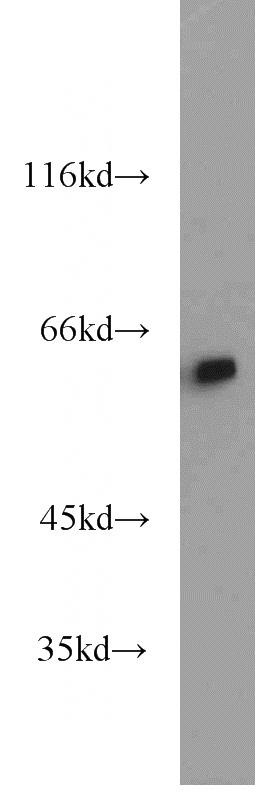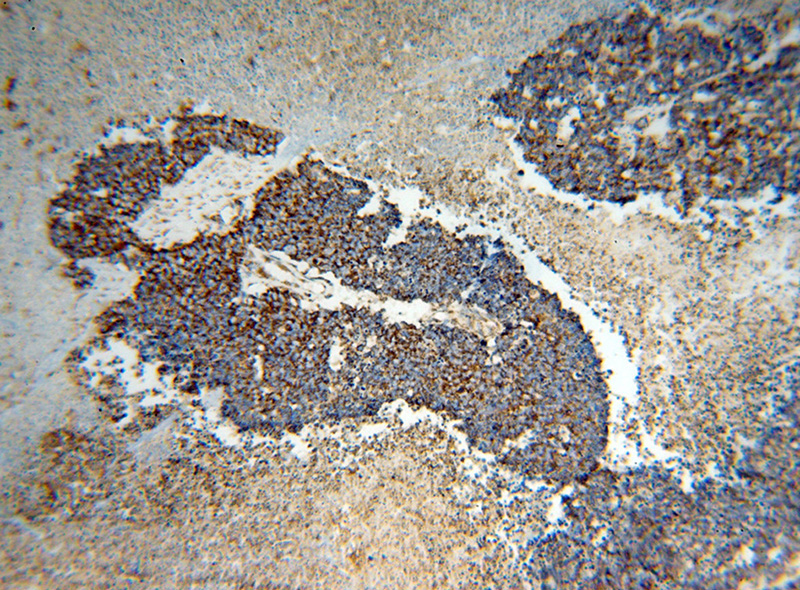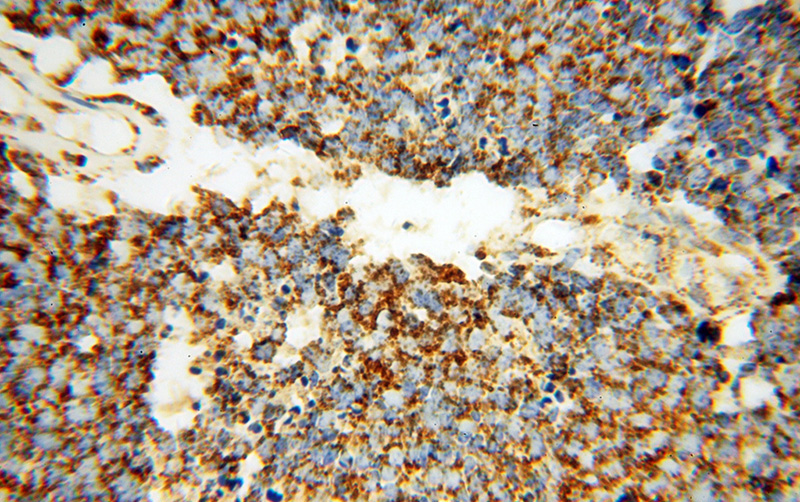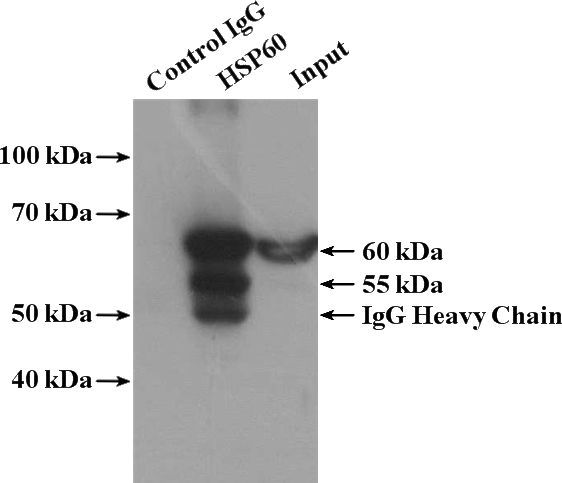-
Product Name
HSP60 antibody
- Documents
-
Description
HSP60 Rabbit Polyclonal antibody. Positive IF detected in HepG2 cells. Positive IHC detected in human lung cancer tissue. Positive IP detected in HEK-293 cells. Positive WB detected in HeLa cells, HepG2 cells, NIH/3T3 cells, rat heart tissue. Observed molecular weight by Western-blot: 60 kDa
-
Tested applications
ELISA, WB, IHC, IF, IP
-
Species reactivity
Human,Mouse,Rat; other species not tested.
-
Alternative names
HSP 60 antibody; HSP60 antibody; HSP65 antibody; HSPD1 antibody
-
Isotype
Rabbit IgG
-
Preparation
This antibody was obtained by immunization of HSP60 recombinant protein (Accession Number: NM_002156). Purification method: Antigen affinity purified.
-
Clonality
Polyclonal
-
Formulation
PBS with 0.02% sodium azide and 50% glycerol pH 7.3.
-
Storage instructions
Store at -20℃. DO NOT ALIQUOT
-
Applications
Recommended Dilution:
WB: 1:1000-1:10000
IP: 1:1000-1:10000
IHC: 1:20-1:200
IF: 1:20-1:200
-
Validations

HeLa cells were subjected to SDS PAGE followed by western blot with Catalog No:111567(HSPD1 antibody) at dilution of 1:6000

Immunohistochemical of paraffin-embedded human lung cancer using Catalog No:111567(HSPD1 antibody) at dilution of 1:100 (under 10x lens)

Immunohistochemical of paraffin-embedded human lung cancer using Catalog No:111567(HSPD1 antibody) at dilution of 1:100 (under 40x lens)

IP Result of anti-HSPD1 (IP:Catalog No:111567, 4ug; Detection:Catalog No:111567 1:4000) with HEK-293 cells lysate 3680ug.

Immunofluorescent analysis of (-20oc Ethanol) fixed HepG2 cells using Catalog No:111567(HSPD1 Antibody) at dilution of 1:50 and Alexa Fluor 488-congugated AffiniPure Goat Anti-Rabbit IgG(H+L)
-
Background
HSPD1, also known as HSP60, belongs to the chaperonin family and acts as a chaperone to enhance cell survival under physiological stresses. Hsp60 has been shown to be connected with many aspects of cell functions such as protein folding and assembling of polypeptide chains in mitochondria. Recently it has been reported that HSP60 is associated with apoptosis or inhibition of cancer cell growth. (21822415)
-
References
- Liu CI, Chen CC, Chen JC. Proteomic analysis of anti-tumor effects of 11-dehydrosinulariolide on CAL-27 cells. Marine drugs. 9(7):1254-72. 2011.
- Li B, Chang J, Chu Y. Membrane proteomic analysis comparing squamous cell lung cancer tissue and tumour-adjacent normal tissue. Cancer letters. 319(1):118-24. 2012.
- Su CC, Su JH, Lin JJ. An investigation into the cytotoxic effects of 13-acetoxysarcocrassolide from the soft coral Sarcophyton crassocaule on bladder cancer cells. Marine drugs. 9(12):2622-42. 2011.
- Su TR, Lin JJ, Chiu CC. Proteomic investigation of anti-tumor activities exerted by sinularin against A2058 melanoma cells. Electrophoresis. 33(7):1139-52. 2012.
- Liu G, Tian H, Huang YQ. Alterations of mitochondrial protein assembly and jasmonic acid biosynthesis pathway in Honglian (HL)-type cytoplasmic male sterility rice. The Journal of biological chemistry. 287(47):40051-60. 2012.
- Yang MS, Wang HS, Wang BS. A comparative proteomic study identified calreticulin and prohibitin up-regulated in adrenocortical carcinomas. Diagnostic pathology. 8:58. 2013.
- Li HH, Su JH, Chiu CC. Proteomic investigation of the sinulariolide-treated melanoma cells A375: effects on the cell apoptosis through mitochondrial-related pathway and activation of caspase cascade. Marine drugs. 11(7):2625-42. 2013.
- Cheng KC, Huang HH, Hung CT. Proteomic analysis of the differences in orbital protein expression in thyroid orbitopathy. Graefe's archive for clinical and experimental ophthalmology = Albrecht von Graefes Archiv für klinische und experimentelle Ophthalmologie. 251(12):2777-87. 2013.
Related Products / Services
Please note: All products are "FOR RESEARCH USE ONLY AND ARE NOT INTENDED FOR DIAGNOSTIC OR THERAPEUTIC USE"
